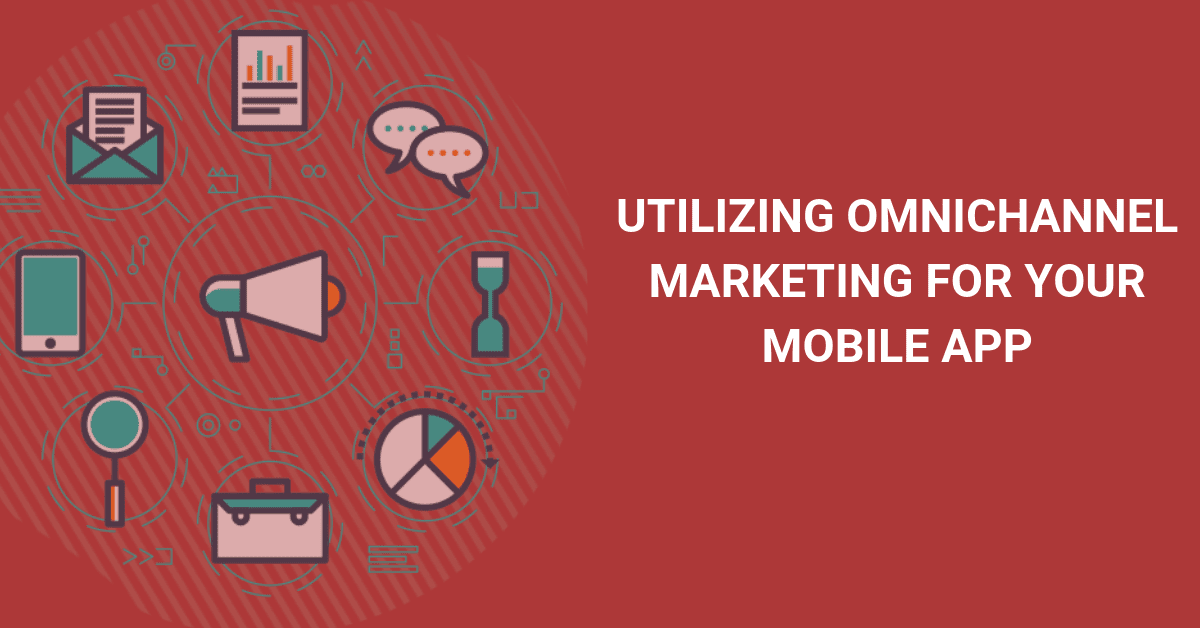4 Ways Omnichannel Marketing Can Be Utilized for Mobile Apps

Reading Time: 6 minutes
Mobile applications have become an indispensable part of our life. Be it ordering dinner when you are getting late, hailing a cab, or just watching a movie on Netflix while you are stuck in traffic. Everything is possible with a tap or a swipe of your finger.
Lisa Gevelber, Google’s VP of Marketing, says that in moments of need, 96% of the users reach out to their smartphone to find answers. They have become so integral to the decision-making process that 70% of smartphone owners turn to their devices before making a purchase in-store.
That’s why it comes as no surprise that individuals spend 50% of their time on mobile apps.
From a business perspective, mobile apps are emerging as one of the reliable channels for driving conversions. The State of Mobile 2019 reported 194 billion mobile app downloads in 2018, a clear indication that this is one channel that can bring you sales if utilized the right way.
However, with more than 2.1 million apps listed on the Android play store and more than 1 million on Apple’s app store, garnering the attention of your customers and prospects on an app can be quite a task.
And even if you get them to your app, keeping them engaged on your platform and reducing the churn by retaining them requires some marketing efforts.
That’s where omnichannel marketing strategy comes to help. It helps you to keep your users invested in your app throughout the customer journey – right from the time you onboard them till the time you retain and convert them into brand advocates.
| Bonus Content
👉 Beginner’s Guide to Omnichannel Marketing for 2021 [Download Ebook] 👉 Definitive Buyer’s Guide To Customer Engagement Platform [Download Ebook] 👉 Retail Strategies and Omnichannel Engagement Frameworks [Download Ebook] |
Why Use Omnichannel Marketing to Engage Mobile Users?
Omnichannel marketing offers you multiple benefits, which include:
a) Personalizing offers for the users: A research by Infosys reveals that 31% of the surveyed consumers expected better personalization in their shopping experience than the current one. In an era of Netflix and Amazon, a brand that personalizes the user’s experience, especially on mobile apps, witnesses more growth than the non-personalized ones. Omnichannel marketing allows you to segment your users based on different parameters and deliver personalized offers to them.
b) Enabling frictionless shopping experiences across devices: Worldpay reveals that 67% of the shoppers begin their shopping on one device and finish it on the other device. A user might lose interest in your brand if they have to search and add items all over again after switching devices. Omnichannel marketing lets you create a seamless experience not only on the web but also on a mobile app for your users; so users can shop anywhere, anytime without going through the drill of searching, adding, and completing transactions repeatedly.
c) Generates higher AOV: According to a study by OmniSend, customers who interact with a campaign on three or more channels are more likely to purchase and come back for repeat purchase than those who interact with a single-channel campaign. The study further revealed that the Average Order Value for an omnichannel campaign was 13% higher than that of a single-channel campaign.
Four Ways Omnichannel Marketing Can be Utilized for Mobile Apps
Considering that your mobile app has the potential to drive sales and generate revenue, we have put together four ways in which you make the best out of omnichannel marketing throughout the customer’s journey.
1. Welcome the new users
Imagine walking into a store where no one pays attention to you. The next thing you would do is walk out of the store. With mobile apps, things get more challenging because there is no human contact. That’s why it’s all the more crucial to have an effective onboarding strategy in place. With omnichannel marketing, you can walk your user through different features such as how to use the app, how to complete your profile, how to complete a transaction, etc. You can set triggers and send personalized messages through push notifications and emails to encourage them to use your app. You can even design welcome offers to nudge your new customers to make the first purchase on your app. Tokopedia, Indonesia’s largest online marketplace, used an integrated onboarding strategy to engage the newly acquired users on their app. They identified various steps from onboarding to brand discovery to send the right message at the right time and to eliminate ambiguity in user experience. The targeted onboarding campaign resulted in a 60% increase in user retention and 20% increase in the first purchase transaction.
2. Keep them engaged
Do you know on average, users uninstall a mobile app within 5.8 days after being used? There could be several reasons for it, ranging from low memory storage to high battery usage. While you may not have control over these factors, what you can certainly control is the uninstallation of apps due to low engagement. Omnichannel marketing enables you to analyze the reason behind the low user engagement and helps you to create relevant and rich push notifications that would remind the user to interact with your app in some way or the other. Sometimes driving engagement can be a challenge given the nature of the business. In such cases, marketers have to think of delivering unique content and personalized offers to keep the users invested in the app. In one of the growth marketing sessions with MoEngage, Pranav Kumar, the head of CRM at OYO rooms gave an example of how they increased engagement on their app. OYO has a chain of 18000+ hotels in 500 cities in India. Considering that users would not be looking for a hotel frequently, OYO came up with a flagship program called OYOQ, a quiz-based program that led the user to engage with the app regularly. This led to a top-of-mind-recall and improved the rate of conversions and revenue.
Tip: While sending push notifications to improve engagement is a good idea, ensure that the notifications are relevant to them and are sent at the right time. Bombarding the user with irrelevant notifications at odd timings could lead them to uninstall your app.
3. Try not to let them go
According to Bain and Company, even a 5% increase in retention can increase the ROI by 95%. In a highly competitive ecosystem of mobile apps, you have to think of ways to re-engage your inactive users to reduce the churn. The ideal way to begin is by identifying the users who have completely stopped using the app and finding ways to recapture their attention. With omnichannel marketing, you can set personalized push notifications to be sent right before the user uninstalls the app. This will give the user a reason to re-engage with the mobile app. You can also create in-app surveys to know what’s stopping your users from engaging with your app and remove the common roadblocks to reduce the churn. Fave, a fitness startup in South East Asia improved the customer LTV by 2x by re-engaging the users and encouraging them to make a repeat purchase on the app. Fave segmented the users based on the purchase made by them on the app and sent them personalized push notifications to inform them of some of the best deals and benefits they could avail by shopping on the app.
4. Turn them into brand advocates
91% of the consumers trust online reviews as much as personal recommendations. It is, therefore, crucial to convert your app users into brand advocates. The easiest way to do it is by enabling your users to rate and review your app on the play store or app store. Although the glitch here is that most consumers are reluctant to share positive feedback. Adopting an omnichannel approach could help you to turn your customers into brand advocates. From conducting in-app surveys to requesting for a review a few days after the user has purchased a product from your app, create a brand advocacy plan and use different marketing channels such as emails to encourage users to share their feedback. Kredivo, a fintech company in Indonesia, sent automated emails to users (who had made in-app purchases) to share their ratings and feedback. The email campaign led to a 64% conversion rate.
We hope these four tactics will help you plan omnichannel marketing strategies for your mobile app across various stages of the customer journey.
For more tips and tricks on how to use omnichannel marketing strategies in your campaign, follow our blog. We promise you to bring the latest news, insights, and fresh ideas to strengthen your strategy.








